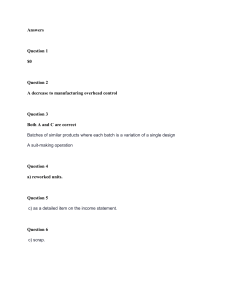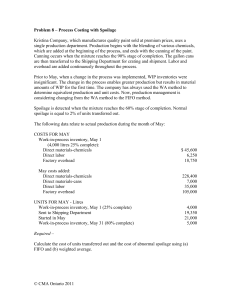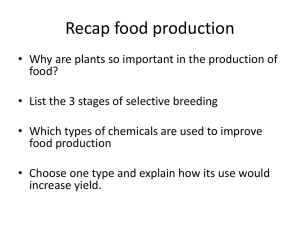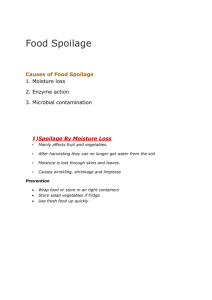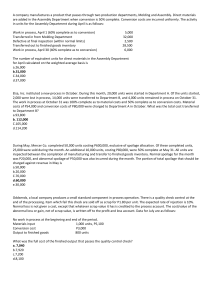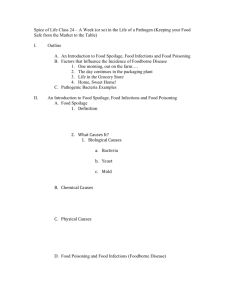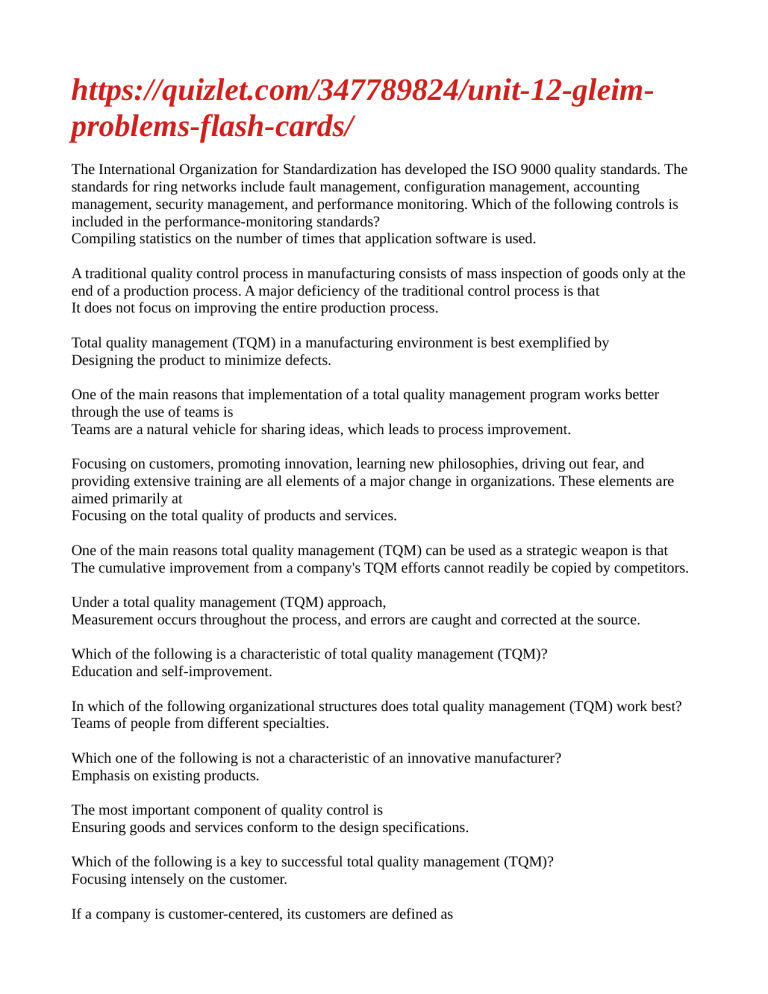
https://quizlet.com/347789824/unit-12-gleimproblems-flash-cards/ The International Organization for Standardization has developed the ISO 9000 quality standards. The standards for ring networks include fault management, configuration management, accounting management, security management, and performance monitoring. Which of the following controls is included in the performance-monitoring standards? Compiling statistics on the number of times that application software is used. A traditional quality control process in manufacturing consists of mass inspection of goods only at the end of a production process. A major deficiency of the traditional control process is that It does not focus on improving the entire production process. Total quality management (TQM) in a manufacturing environment is best exemplified by Designing the product to minimize defects. One of the main reasons that implementation of a total quality management program works better through the use of teams is Teams are a natural vehicle for sharing ideas, which leads to process improvement. Focusing on customers, promoting innovation, learning new philosophies, driving out fear, and providing extensive training are all elements of a major change in organizations. These elements are aimed primarily at Focusing on the total quality of products and services. One of the main reasons total quality management (TQM) can be used as a strategic weapon is that The cumulative improvement from a company's TQM efforts cannot readily be copied by competitors. Under a total quality management (TQM) approach, Measurement occurs throughout the process, and errors are caught and corrected at the source. Which of the following is a characteristic of total quality management (TQM)? Education and self-improvement. In which of the following organizational structures does total quality management (TQM) work best? Teams of people from different specialties. Which one of the following is not a characteristic of an innovative manufacturer? Emphasis on existing products. The most important component of quality control is Ensuring goods and services conform to the design specifications. Which of the following is a key to successful total quality management (TQM)? Focusing intensely on the customer. If a company is customer-centered, its customers are defined as Anyone external to the company and those internal who rely on its product to get their job done. Quality control circles are now used all over the world. They typically consist of a group of 5 to 10 employees who meet regularly. The primary goal of these circles is To tap the creative problem-solving potential of every employee. The four categories of costs associated with product quality costs are External failure, internal failure, prevention, and appraisal. A company produced and sold 100,000 units of a component with a variable cost of $20 per unit. Firstquality components have a selling price of $50. The component's specifications require its weight to be 20 kg. with a tolerance of ±1 kg. Unfortunately, 1,200 of the units produced failed the company's tolerance specifications. These 1,200 units were reworked at a cost of $12 per unit and sold as factory seconds at $45 each. Had the company had a quality assurance program in place such that all units produced conformed to specifications, the increase in the company's contribution margin from this component would have been $20,400 In a quality control program, which of the following is (are) categorized as internal failure costs? I. Rework II. Responding to customer complaints III. Statistical quality control procedures I only. Management of a company is attempting to build a reputation as a world-class manufacturer of quality products. Which of the four costs would be the most damaging to its ability to build a reputation as a world-class manufacturer? External failure costs. All of the following generally are included in a cost-of-quality report except Lost contribution margin. Nonfinancial performance measures are important to engineering and operations managers in assessing the quality levels of their products. Which of the following indicators can be used to measure product quality? I. Returns and allowances II. Number and types of customer complaints III. Production cycle time I and II only. In Year 4, a manufacturing company instituted a total quality management (TQM) program producing the following report: On the basis of this report, which one of the following statements is most likely true? An increase in conformance costs resulted in a higher-quality product and a decrease in nonconformance costs. Management of a company is attempting to build a reputation as a world-class manufacturer of quality products. Which of the following measures would not be used by the firm to measure quality? The number of parts shipped per day. Conformance is how well a product and its components meet applicable standards. According to the robust quality concept, Every unit should reach a target value. Quality cost indices are often used to measure and analyze the cost of maintaining or improving the level of quality. Such indices are computed by dividing the total cost of quality over a given period by some measure of activity during that period (for example, sales dollars). The following cost data are available for a company for the month of March. The company's quality cost index is calculated using total cost of quality divided by sales dollars. Sales $400,000 Direct materials cost 100,000 Direct labor cost 80,000 Testing and inspection cost 6,400 Scrap and rework cost 16,800 Quality planning cost 2,800 Cost of customer complaints and returns 4,000 The quality cost index for March is 7.5% According to current accounting literature, the dimensions of quality most likely include Yes Yes No The following information is available for Portia Co. for its past 2 fiscal years: Conformance costs to total quality costs increased from 17.56% in Year 1 to 37.44% in Year 2. The Plan-Do-Check-Act (PDCA) Cycle is a quality tool devised by W.E. Deming. It is best described as A management by fact approach to continuous improvement. Which of the following quality costs are nonconformance costs? Environmental costs. Quality costing is similar in service and manufacturing entities. Nevertheless, the differences between these entities have certain implications for quality management. Thus, External failure costs are relatively greater in service entities. According to the robust quality concept, Costs in all categories of quality costs may be reduced while improving quality. A manufacturer that wants to improve its staging process compares its procedures against the check-in process for a major airline. Which of the following tools is the manufacturer using? Benchmarking. A company manufactures diamond earrings and pendants. The company uses activity-based budgeting and has established diamond inspection as one of its cost pools with number of diamonds used as its cost driver. Inspection supplies for each diamond inspected are $0.35. For the upcoming year, the company originally believed it would produce and sell 10,000 pendants containing one diamond and 5,000 sets of earrings containing two diamonds, resulting in the following inspection cost per diamond. $7.70 Which of the following statements regarding benchmarking is false? The benchmarking organization against which a firm is comparing itself must be a direct competitor. An example of an internal nonfinancial benchmark is the Percentage of customer orders delivered on time at the company's most efficient plant becoming the benchmark for the company's other plants. Listed below are selected line items from the cost of quality report for Watson Products for last month. What is Watson's total prevention and appraisal cost for last month? $1,940 Product-quality-related costs are part of a total quality control program. A product-quality-related cost incurred in detecting individual products that do not conform to specifications is an example of a(n) Appraisal cost. As part of a benchmarking process, a company's costs of quality for the current month have been identified as follows: What amount is the company's prevention cost for the current month? $57,000 Which of the following methods involves comparing a company's internal processes that need to be improved to those of external companies identified as being best in class? Benchmarking. To evaluate its performance, Blankie Co. is comparing its costs of quality from one year to the next. The relevant costs are as follows: Which of the following conclusions can Blankie draw about its quality program? It has been a success, because conformance costs increased by $25,000 while nonconformance costs decreased by $40,000. Last year a consulting company that solves computer network problems instituted a total quality management (TQM) program and produced the following summary cost-of-quality report: Which of the following statements regarding the report is most likely correct? An increase in conformance costs resulted in a decrease in nonconformance costs. Which of the following methodologies would be most effective for a company that wants to reduce its rate of defective products? Six Sigma. A company produces stereo speakers for automobile manufacturers. The automobile manufacturers emphasize total quality control (TQC) in their production processes and reject approximately 3% of the stereo speakers received as being of unacceptable quality. The company inspects the rejected speakers to determine which ones should be reworked and which ones should be discarded. The discarded speakers are classified as Spoilage. Spoilage from a manufacturing process was discovered during an inspection of work in process. In a process costing system, the cost of the spoilage would be added to the cost of the good units produced if the spoilage is No Yes Normal spoilage is defined as Spoilage that results from normal operations. A manufacturing firm has a normal spoilage rate of 4% of the units inspected; anything over this rate is considered abnormal spoilage. Final inspection occurs at the end of the process. The firm uses the FIFO inventory flow assumption. The processing for the current month was as follows: 19,336 units 3,264 units Forming Department is the first of a two-stage production process. Spoilage is identified when the units complete the forming process. Costs of spoiled units are assigned to units completed and transferred to the second department in the period spoilage is identified. The following concerns Forming's conversion costs: $67,500 If a process has several inspection points, how should the costs of normal spoilage be accounted for? Assigned to the good units passing through each inspection point. In a process costing system in which normal spoilage is assumed to occur at the end of a process, the cost attributable to normal spoilage should be assigned to Cost of goods manufactured (transferred out). In a job costing system, $45,000 has been charged to a job ($25,000 of direct materials, $10,000 direct labor, and $10,000 applied overhead). The job yields 500 units of a product, of entity 100 are rejected as spoiled with no salvage value. The cost of the spoilage is determined to be $9,000. If the entity wishes to use this job as the basis for setting a spoilage standard for comparison with future work, the conceptually superior way to express the spoilage rate is 25% of good outputs. Shrinkage should be accounted for as Spoilage. Abnormal spoilage Is not expected to occur under efficient operating conditions. A manufacturing firm may experience both normal and abnormal spoilage in its operations. The costs of both normal and abnormal spoilage are accounted for in the accounting records. The costs associated with any abnormal spoilage are Charged to a special abnormal spoilage loss account. What is a quantity of production report? A report that states the units transferred into one or more manufacturing accounts during a period and the disposition of those units. What is a cost of production report? A report that lists and accounts for all debits to the manufacturing account during the period and the disposition of those costs. In its production process, Hern Corp., which does not use a standard cost system, incurred total production costs for the month of $90,000, of which Hern attributed $60,000 to normal spoilage and $30,000 to abnormal spoilage. Hern should account for this spoilage as Inventoriable cost of $60,000 and period cost of $30,000. A department adds material at the beginning of a process and identifies defective units when the process is 40% complete. At the beginning of the period, there was no work in process. At the end of the period, the number of work-in-process units equaled the number of units transferred to finished goods. If all units in ending work in process were 66% complete, then ending work in process should be allocated 50% of all normal defective unit costs. In manufacturing its products for the month just ended, Elk Co. incurred normal spoilage of $10,000 and abnormal spoilage of $12,000. How much spoilage cost should Elk charge as a period cost for the month? $12,000 A company uses a job-order cost system in accounting for its manufacturing operations. Because its processes are labor oriented, it applies manufacturing overhead on the basis of direct labor hours (DLH). Normal spoilage is defined as 4% of the units passing inspection. The company includes a provision for normal spoilage cost in its budgeted manufacturing overhead and manufacturing overhead rate. Data regarding a job consisting of 30,000 units are presented below: $4,140 The normal spoilage rate for a company is 5% of normal input. A current job consisted of 31,000 total units, of which 28,500 good units were produced and 2,500 units were defective. The amount of abnormal spoilage on this job is 1,000 units. During the month of May, a company completed 50,000 units costing $600,000, exclusive of spoilage allocation. Of these completed units, 25,000 were sold during the month. An additional 10,000 units, costing $80,000, were 50% complete at May 31. All units are inspected between the completion of manufacturing and transfer to finished goods inventory. Normal spoilage for the month was $20,000, and abnormal spoilage of $50,000 was also incurred during the month. The portion of total spoilage that should be charged against revenue in May is $60,000 Assume 550 units were worked on during a period in which a total of 500 good units were completed. Normal spoilage consisted of 30 units; abnormal spoilage, 20 units. Total production costs were $2,200. The company accounts for abnormal spoilage separately on the income statement as loss due to abnormal spoilage. Normal spoilage is not accounted for separately. What is the cost of the good units produced? $2,120 A company makes lenses for telescopes. Because the company will only sell lenses of the highest quality, the normal spoilage during a reporting period is 1,000 units. At the beginning of the current reporting period, the company had 2,200 units in inventory, and during the period, production was started and completed on 4,000 units. Units in inventory at the end of the current reporting period were 1,500, and the units transferred out were 3,000. During this period, the abnormal spoilage for the company's lens production was 700 units. Which of the following techniques effectively measures improvements in product quality as a result of internal failure costs? Tracking the number of products reworked. A calendar-year corporation had $17,000 of spoilage during April that production management characterized as abnormal. The spoilage was incurred on Job No. 532, which was sold 3 months later for $459,000. Which of the following correctly describes the impact of the spoilage on the corporation's unit manufacturing cost for Job No. 532 and on the year's operating income? No effect Decrease Scrap consists of Materials remaining from the production cycle but usable for purposes other than the original purpose. A product that does not meet quality control standards and needs to be reworked to be salable as either an irregular or a good product is classified as Defective goods. During the month just ended, Delta Co. experienced scrap, normal spoilage, and abnormal spoilage in its manufacturing process. The cost of units produced includes Scrap and normal spoilage, but not abnormal spoilage. The sale of scrap from a manufacturing process usually is recorded as a(n) Decrease in factory overhead control. Rework costs should be regarded as a cost of quality in a manufacturing company's quality control program when they are I. Caused by the customer. II. Caused by internal failure. II only. Some units of output failed to pass final inspection at the end of the manufacturing process. The production and inspection supervisors determined that the estimated incremental revenue from reworking the units exceeded the cost of rework. The rework of the defective units was authorized, and the following costs were incurred in reworking the units: The manufacturing overhead budget includes an allowance for rework. The predetermined manufacturing overhead rate is 150% of direct labor cost. The account(s) to be charged and the appropriate charges for the rework cost would be Overhead control for $40,300. Assuming the value of scrap sales is material, when is it not necessary to record the scrap in inventory as it is produced? When it is sold regularly, e.g., daily, weekly, etc. Hart Company incurred the following costs on Job 109 for the manufacture of 200 motors:. $15.80 https://quizlet.com/427201241/cost-accountingchapter-1-flash-cards/ The set of activities that transforms raw resources into the goods and services end users purchase and consume is called the: value chain. Which of the following activities would not be considered a value-added activity? Accounting Which of the following statements is false? Financial accounting information is important because it is sufficient to provide all the information for operational decisions commonly made by managers. Managers do not make decisions about future events based on: Perfect information. Which of the following is a nonvalue-added activity? Rework of defective items (CMA adapted) A costing method that first assigns costs to activities and then assigns them to products based on the products' consumption of those activities is: activity-based costing. (CMA adapted) Cost drivers are: activities that cause costs to increase as the activity increases. During 2020, the Beach Restaurant had sales revenues and food costs of $800,000 and $600,000, respectively. During 2021, Beach plans to introduce a new menu item that is expected to increase sales revenues by $100,000 and food costs by $40,000. Assuming no changes are expected for the other food items, operating profits for 2021 are expected to increase by: $60,000. (CMA adapted) The process of creating a financial plan of the revenues and resources needed to carry out activities and meet financial goals is referred to as: budgeting. The field of accounting that reports according to generally accepted accounting principles (GAAP) is called: financial accounting. The field of accounting that focuses on the criterion of relevant information rather than comparability of firms is: cost accounting. The just-in-time (JIT) method of production focuses on: reducing inventories. (CIA adapted) The primary reason for adopting total quality management (TQM) is to achieve: greater customer satisfaction. According to the Institute of Management Accountants (IMA), the final step in resolving an ethical dilemma is to: consult your own attorney as to legal obligations and rights concerning the ethical conflict. According to the Institute of Management Accountants (IMA), the first step in resolving an ethical dilemma is to: discuss the situation with an immediate supervisor, except when it appears that the supervisor is involved, or with the next level supervisor if involvement of the immediate supervisor is suspected. Which of the following is not one of the basic standards of the Institute of Management Accountants (IMA) Code of Ethics? Honesty Which of the following is not one of the overarching ethical principles of the Institute of Management Accountants (IMA) Code of Ethics? Competence A general term for a metric that indicates how well an individual, business, product, or firm is working is called: a performance measure. The cost accounting system that minimizes wasteful or unnecessary transaction processes is: Lean Accounting
